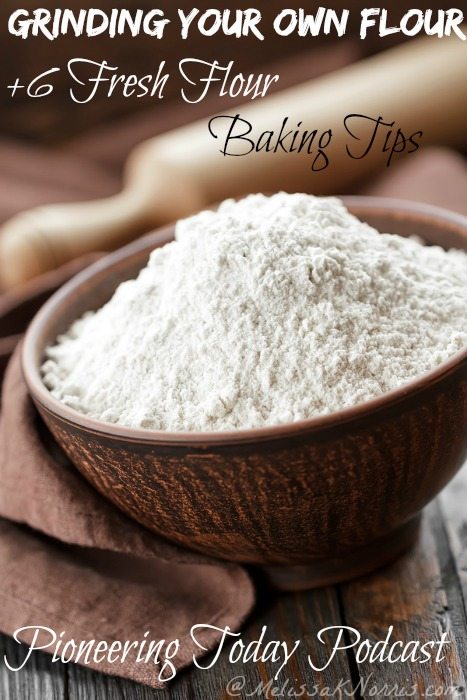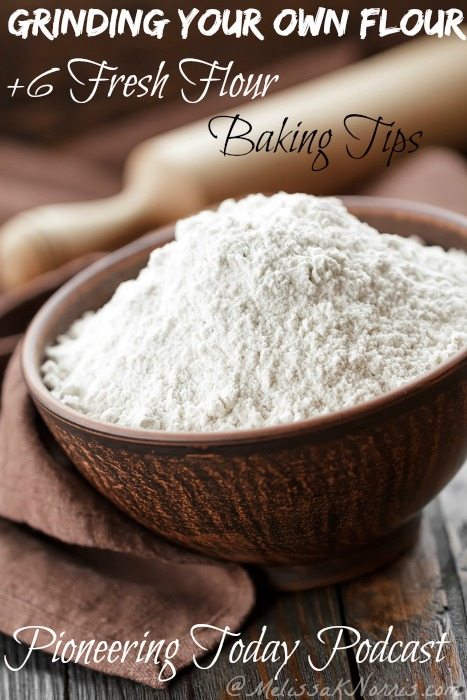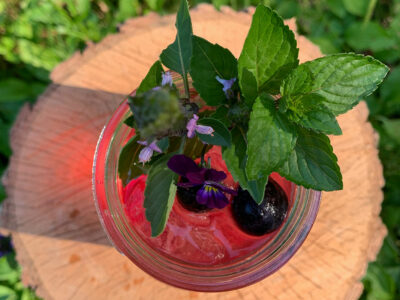Baking with fresh milled flour you’ve ground at home is quite different than store bought flour. Grinding my own flour at home makes me feel like a real pioneer woman.

However, the first few weeks of baking with my fresh ground flour left me more than a little frustrated with dense breads and spread out pancake cookies. I’ve now been grinding my own flour and using fresh flour in all of our baking for almost two years and I’ve learned some tips to save you some time.
Today’s podcast is an entire episode dedicated to grinding your own flour at home, choosing which kind of wheat is best suited to for different types of baking, and tips for baking with fresh flour. After getting lots of questions about these topics, I decided an entire podcast was in order to help answer your questions.
Table of Contents[Hide][Show]
Baking with Fresh Milled Flour
First thing we need to go over is the wheat berry. It doesn’t look like a fruit berry but more a hard kernel (this totally perplexed me at first, I was picturing a golden squishy berry). The first part of the wheat berry is the bran, which is the hard outside where a lot of the fiber and nutrients are.
The second part is the germ. This is where the oil resides, filled with vitamins, proteins, and minerals. It’s where the goods are ya’ll.
The third part is the endosperm, a large part of the berry and where most of the starch is. This is what regular flour from the store is made out of.
Here’s a fun picture and diagram of a wheat berry if you’re a visual person. (That’d be me)
The other two parts of the wheat berry are not in store bought flour because the oil turns rancid quickly, meaning it wouldn’t stay shelf stable. So whenever you see “enriched” on flour labels, it’s because they have to put back in the vitamins and minerals they’ve taken out.
Grinding your own flour at home means you get all of the good parts of the wheat berry in your flour. No need to add anything back in because it’s all there in the first place. This is one of the reasons we started grinding our own flour. The second is the storage life of wheat berries. They’ll store for many many years, where as flour is only good for up to a year or so. I’m always looking for ways to increase our self-sufficiency and food storage. Can I get a high five?
Disclosure: Some of the below links are affiliate links. Thank you for supporting this website.
If you’re wondering about wheat grinders, whether or not to go with a manual or electric and the pros and cons, I’ve got an entire article going over which grinder is right for you and your family in Why You Should Grind Your Own Flour and Choosing a Mill.
I’ve personally tried and owned both a Wondermill and Mockmill, both were sent to me for free to try for review, and after trying the Mockmill, I gave my Wondermill away. Yep, it’s that much better. I do have a manual back up grinder for emergencies, out of power, etc.
There are two general types of wheat berries, hard and soft. Hard wheat has higher protein and more gluten, which is good for certain types of baking. Gluten is what gives bread it elasticity and soft texture. My family and I are not sensitive to gluten and enjoy our bread products.
I prefer hard white wheat to hard red wheat in my baking. I use hard red wheat for tortillas and crackers, but I like hard white wheat for breads and rolls. Hard white wheat is sweeter and lighter and what I use in my Whole Wheat Honey Buttermilk Sandwich Bread.
Soft wheat is preferred for pastry type items as it’s lower in protein, and I used it until I discovered…. Spelt!
I actually prefer to use Spelt as my pastry flour. Spelt is a primitive ancient grain dating all the way back to Biblical times. I was reading in my Bible a few weeks back and Spelt was mentioned by name. I got kinda of giddy. Like looked for my husband to show him.
Spelt has a higher protein count and does contain gluten, though not the levels of regular hybridized wheat. I use spelt in biscuits, cookies, muffins, cakes, and quick breads. Some people who are sensitive to gluten (not celiacs) have been able to eat spelt in small amounts.
Tips for baking with fresh ground flour.
1. Fresh milled flour right out of the grinder is warm. This is great for yeast breads. This is not great for pastry items that require the cutting in of cold butter or lard. To get a flaky pastry you need the butter to melt when it’s baking in the oven, not when it’s being mixed together. When I need my flour to be cool for pastry needs, I’ll grind it and pop it in the fridge for a while or in the freezer if I’m in a hurry. Let’s face it, I’m in a hurry a lot… Want a fabulous flaky pie crust recipe? Click here for my Great Grandmother’s Flaky Pastry Crust.
2. You have to alter the amount of fresh ground flour for your recipes using all-purpose flour.When working with flours other than spelt, you need to use less flour. Fresh flour absorbs liquid more than store bought flour. The first month of using fresh flour I couldn’t make bread. It was sooo hard by the time I was supposed to punch it down, I couldn’t make an indent in the dough with my first. Yeah, that dense. And I’d been baking bread my whole life! Hello, something was wrong. So that something was me as I wasn’t altering my recipes. Generally, I use 3 Tablespoons less per cup of flour in a recipe.
For spelt flour, you need to use 2 to 4 Tablespoons more flour per cup.
3. You have to go by the feel and look of your dough, not the called for amounts. Start with a lesser amount of flour. You can add more in but you can’t take it back out. Because the flour will absorb liquid wait before adding more flour. Mix until it sticks together, but is still tacky or sticky to the touch of your finger.
4. Don’t over knead your fresh milled flour dough! Here’s my rule for kneading with fresh flour. Knead dough for 4 minutes, let it rest for 1o to 15 minutes (or 20 if you get busy, don’t set a timer, and totally forget…) Then come back and knead for 4 more minutes. You’ll notice the dough has absorbed the liquid and isn’t as sticky as it was before the rest period.
5. Don’t add more flour when kneading. This was where I really went wrong. I kept adding flour wanting my dough to feel soft like it did with store bought flour. How do you knead without extra flour? Use a small amount of olive oil, coconut oil, or avocado oil on your counter and hands to knead without it sticking. If you’re using a stand mixer to knead, then don’t worry about the oil. My Kitchen Aid Pro does a bang up job and I heart it.
6. Having rising problems or flat bread? Spelt likes to rise out instead of up. Just the way it rolls- er rises. For free form baked goods like cookies, I do have a small bag of organic all-purpose flour and I’ll use some of that for cookies, like 1 cup of all-purpose to 2 cups of spelt flour (the only thing I add it to, everything else is all home milled flour). I read you could use a percentage of barley flour with your spelt or soft wheat flour to create an all-purpose at home, but I haven’t done it yet, so stay tuned…. For flat or deflated bread issues, try cutting back your rise time by 15 to 20 minutes. It sounds like the yeast is spent by the time it hits the oven.
This is my big bread tip. Preheat the oven to 425 degrees, bake bread at this high temperature for 4 minutes, then turn the oven down to 375 degrees for the remainder of the time. This extra high heat will kick that bread up and make it rise baby, rise. I read this tip on a recipe review site somewhere and can’t remember where, so if it was you, thanks a bunch!
You might not have enough gluten. You can add vital wheat gluten to help with the rise. I use 1/4 cup vital wheat gluten to 8 cups flour. It’s a powder and available in the bulk food sections at most stores.
How much flour does one cup of wheat berries make?
I generally get about 1 and 1/4 cup flour from 1 cup wheat berries. I don’t sift my flour. I’m a busy mamma. I grind it, measure, and go.
Where to purchase wheat berries?
I purchase my wheat berries in 50 pound bags from our local co-op. I get a 10% discount from purchasing in bulk. We use 50 lbs or organic hard white wheat and 50 pounds of organic Spelt berries in a year.
Don’t have a co-op? No worries. You can purchase bulk bags on-line if you don’t have a co-op or local grainery near you. The best deals I’ve found on-line are actually from our affiliate partner Amazon and is a Washington state company! Go home state, go home. This is Non-GMO verified, kosher, hard white wheat *affiliate link from Palouse available in 3, 5, and 25 lbs. bags. Bob’s Red Mill has organic spelt wheat berries *affiliate link and you may be able to find it locally. I have found hard red wheat at almost all grocery stores, but spelt has been the hardest for me to find.
Do you grind your own wheat at home? What kind of wheat do you use the most? Do you have any tips to add?



